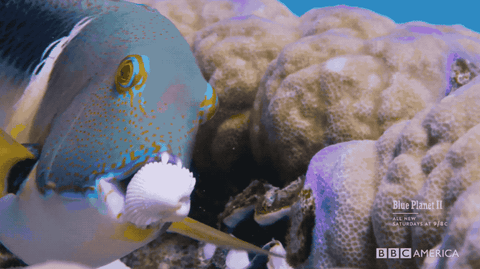If you're into nature documentaries, then you know that anything involving Sir David Attenborough is the gold standard — he can make regular old ants sound like the most interesting creatures in the world. He's back again with Blue Planet II (airing now on BBC America), which is all about the stuff that lives inside the ocean. The ocean, in case you weren't already clear on this, is crazy. Sure, you've got your dolphins and your whales, your cute little Nemo fish and your seahorses, but there's also stuff in there that is more insane than you can even believe. (Any viewing of Blue Planet should include at least 10 minutes of you screaming, "No way, that's not real.")
Advertisement - Continue Reading Below
Each week, check back here for a recap of the coolest, most absurd creatures Sir David discusses in each episode. You'll never want to go in the ocean again!
EPISODE 1: "One Ocean"
The orange-dotted tuskfish.
The orange-dotted tuskfish is a type of wrasse that lives in the Indian Ocean and the western Pacific. It looks like any semi-exotic fish you'd see in a fancy aquarium, but no. It's called a tuskfish because it has little teeth that it uses to pick up clamshells, which it then beats against coral until the shell cracks open so the fish can eat the meat inside. "Here is a fish that uses tools," says Sir David. "Some fish are much cleverer than you might suppose." Uh, no shit. Never let this thing inside your house or it will kill you in your sleep.
Advertisement - Continue Reading Below
The giant trevally.
Once again, the average look of this fish hides a truly special beast. The giant trevally, native to the Indian and Pacific Oceans, is cool because it can leap full out of the water to catch terns that fly too close to the surface. Says Sir David: "So there is a fish here that, amazingly, has a brain capable of calculating the air speed, altitude, and trajectory of a bird." This fish went to college, is what he's saying.
The Asian sheepshead wrasse.
Advertisement - Continue Reading Below
Advertisement - Continue Reading Below
Take a seat, because you are not ready for this. Remember that part in the original Jurassic Park when Jeff Goldblum figures out that the frogs they're using to fill in gaps in dino DNA are actually changing sex so the "all-female" dinosaurs are also changing sex? Life, uh, finds a way and all that? Well, the Asian sheepshead wrasse, also known as the kobudai, is a real fish that is capable of changing sex.
Once females of the species reach a certain size, they begin rejecting advances of males not because the males have no game but because they're about to become male themselves and thus don't need a man. "Over just a few months, particular enzymes inside her body cease to work and male hormones start to circulate," explains Sir David. "As time passes her head expands and her chin gets longer. A she has changed into a he."
Once this happens, the new male can challenge the old male who was all up in her shit earlier and then start mating with the females. And one more fun fact: "The more bulbous the head, the more it intimidates an opponent." Giant sheepshead wrasse — the only species that actually wants a fivehead.
Advertisement - Continue Reading Below
Slapping orcas.
Technically there is no such a thing as a slapping orca and this is just about regular orcas, but since I'd never heard of this behavior prior to "One Ocean" I'm including it anyway. You probably know that orcas are called killer whales because they're super-intense predators, but did you know that they also like to slap the hell out of their prey? That's not a euphemism — they actually slap their tails so hard that the fish they want to eat pass out, just like you when you've had one too many tequila sodas. Or as the more scientific-sounding Sir David puts it, "They beat their tails with such force that the shockwaves stun the herring." I think you can guess what happens to the stunned herring next.
Follow Eliza on Twitter and Cosmo Celeb on Facebook.
Bagikan Berita Ini
























0 Response to "The Coolest Creatures You Meet in Blue Planet II"
Post a Comment